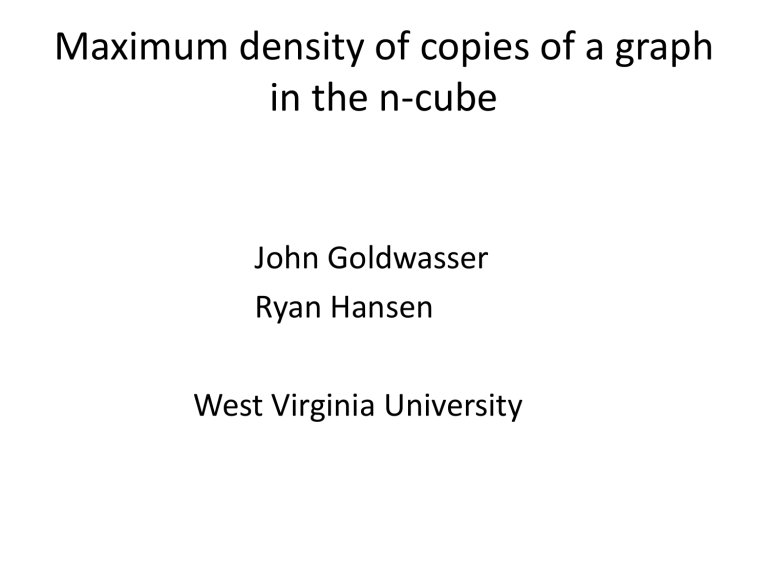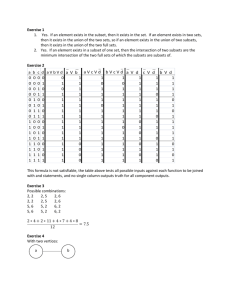Maximum density of exact copies of a graph in the n

Maximum density of copies of a graph in the n-cube
John Goldwasser
Ryan Hansen
West Virginia University
Q n is the n-cube.
V(Q n
) all binary n-tuples.
Two vertices joined by an edge iff differ in precisely one coordinate.
A sub-d-cube has d coordinates that vary, n fixed.
Example with n=10 and d=4:
1 0 * 1 * * 0 1 * 1
There are C(n,d)2 (n-d) sub-d-cubes of Q n
Let d and n be integers (d much smaller than n)
Let H be a set of vertices in a d-cube (which we call a configuration )
MAIN QUESTION : How do you choose vertices in an n-cube so that the maximum possible fraction of subd-cubes have an “exact copy of H”?
Example with d=3
H Not copy of H Copy of H
Formally, given a subset H of the vertices of a d-cube, if S n subset of V(Q n
), we let G(H,d,n,S cubes whose intersection with S n n
) be the number of sub-dis a copy of H. We let is a g(H,d,n) = max G(H,d,n,S n
)/total # sub-d-cubes
(max over all subsets S n of V(Q n
)
An averaging argument shows that g(H,d,n) is a nonincreasing function of n, so we let π(H,d) denote its limit as n goes to infinity, and refer to it as the d-cube density of H .
So π(H,d) is the limit as n goes to infinity of the maximum possible fraction of sub-d-cubes which can have a copy of H.
For the given H above, our construction shows that
F(H,3) ≥ ¾. We conjecture that equality holds.
Example:
H We’ll show π(H,2) = ½
Lower bound construction:
Partition the set {1,2,3,…,n} of coordinates into sets A and B. Let S n be the set of all vertices in Q the number of 1’s in A is even. n such that
If a Q
2 subgraph has one coordinate in A and one in B then it will have an exact copy of H . If A and B are each n/2, that’s half of the Q
2
’s.
So ½ ≤ π(H,2)
For the upper bound, each vertex in a copy of H is adjacent to one vertex in H which is in S which is not. n and one
Each vertex v in the Q n is in C(n,2) sub-2-cubes.
Only those in which one neighbor is in S n not have a chance of being a “good” Q
2 and one is
. This is at most roughly half of the sub-2-cubes containing v.
Since the maximum fraction of “good” sub-2-cubes at any vertex is ½, certainly the maximum fraction overall is at most ½.
We define π local
(H,d) to be the limit as n goes to infinity of the maximum fraction of “good” sub-dcubes at any vertex v for any subset S n of V(Q n
).
Certainly it is at least as big as π(H,d). We have:
½ ≤ π(H,2) ≤ π local
(H,2) ≤ ½
So π(H,2) = ½.
If K is the subset of the 2-cube shown at the right, then π(K,2) = 1. ( Just choose all vertices the sum of whose coordinates is even . )
In general, π(H,d) is hard to determine. We have found its value in only a few special cases.
For the vertex configuration R in Q₃ shown at the right, π (R,3) = 4/9 .
Let P d be a single vertex in Q d
. we have been unable to determine f(R,d) for any d≥2.
A simple construction (choose all vertices with weight a multiple of 3) shows that f(P
2
,2) ≥ 2/3 .
Using flag algebras, Rahil Baber has shown f(P
2
,2) ≤ .6858
f(P
3
,3) ≤ .6101
f(P
4
,4) ≤ .6026
(Is this a monotone sequence? Can you prove it?)
My Conjecture: For sufficiently large d,
π(P d
,d) = [(d-1)/d] (d-1)
(what you get if you choose each vertex with probability 1/2 d )
Of course this is close to 1/e.
Easy Proposition: For any configuration H in Q d
,
π(H,d) ≥ d!/d d
(obtained from a “blow-up” of H)
Example with n = 4, H = {1001, 1101, 0010}
Partition {1,2,3,…,n} into 4 sets of equal size and put the following vertices into S:
A B C D odd even even odd odd odd even odd even even odd even
If a sub-4-cube has one vertex in each of A,B,C,D then it will have a copy of H.
Probability is 4!/4 4 .
If d=3 , there are 14 isomorphically distinct vertex configurations H with at most 4 vertices. We have been able to determine π(H,3) for 4 of them .
The smallest upper bound is .30476 for two adjacent vertices (3!/3 3 = .2222)
If d=4 , there are 238 isomorphically distinct vertex configurations H with at most 8 vertices. We have been able to determine π(H,4) for about 6 of them.
All but two of the flag algebra upper bounds are at least .100.
The other two have flag algebra upper bounds of
.09421 and .09375
They are both 8-cycles.
There are three isomorphically distinct configurations of 8 vertices in Q₄ which induce an 8-cycle. Of these, one is a “perfect” 8-cycle : 4 pairs of vertices distance
4 apart.
The perfect
8-cycle C
8
0000 1000 1100 1110 1111 0111 0011 0001
Main Theorem:
π(C
8
, 4) = 4!/4 4 = 3/32 = .09375
Conjecture:
π(C
2d
, d) = d!/d d for all d>3.
The conjecture can’t hold for d=3. Letting S be all vertices in Q weight not a multiple of 3 is a construction which shows that π(C at least 3/9, and 3!/3 3 = 2/9.
n with
6
,3) is
To prove the theorem it suffices to prove π local
(C
8
,4) ≤ 3/32,
Because then:
3/32 ≤ π(C
8
, 4) ≤ π local
(C
8
, 4) ≤ 3/32
Let P d+1 denote a “perfect path” in Q d
: d+1 vertices in Q d where the Hamming distance between the two end-vertices is d.
Theorem:
π(P
4
, 3) = 3/8
(Proof is using sequence with “Property V”)
Conjecture:
π(P d+1
, d) = d!/(d+1) (d-1) if d ≥ 3.
To do this we considered the set of all sequences of d distinct elements from {1,2,3,…,n}. We showed that the limit, as n goes to infinity, of the fraction of these that satisfy a certain condition we call Property U is equal to π local
(C
8
, 4).
Then we showed that the maximum fraction of these sequences that have Property U is equal to the maximum fraction of sets of 4 vertices in a bipartite graph which span 2 disjoint edges.
Theorem : Let G be a bipartite graph with n vertices.
Then the number of sets of 4 vertices in G which span
2 disjoint edges is at most n 4 /256. Equality holds iff G is 2 disjoint copies of K n/2, n/2
.
The fraction of “good” sets of 4 vertices is the limit as n goes to infinity of [n 4 /256]/C(n,4), which is 3/32.
The problem of finding the graph (not necessarily bipartite) on n vertices which has the greatest number of sets of 4 vertices which span 2 disjoint edges is a special case of a problem solved about 20 years ago by Bollobás, J. Brown and Siderenko.
They showed that among the host graphs on n vertices which span the most copies of a complete bipartite graph is one which itself is complete bipartite. Two disjoint edges is the complement of
K
2,2 and a simple calculation shows that K n/2, n/2 the most induced copies of K
2,2 has the most induced copies of 2 disjoint edges.
has so two copies of K n/2
Comments and questions
For what other vertex configurations H in the d-cube can π(H,d) be calculated?
What about edge configurations, rather than vertex configurations? (We have some results.)
Which bipartite graph with n vertices has the most sets of six vertices which induce three disjoint edges? Is the obvious conjecture correct?









